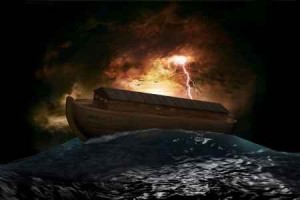The main problem I had in writing this article was that I had to limit it to only seven scientific evidences that support creation over evolution. It is my contention that every scientific fact having to do with origins points to God as creator of the universe. Creation scientists believe that the observable universe we see around us points clearly to God’s hand in creation. The evolutionist does not accept the reality of God; therefore, he or she must attribute what they observe to some force other than God. The quantifiable, observable evidence is the same for both groups, creation scientists and evolutionary scientists; it is the worldview held by each of these groups that causes them to interpret that evidence differently.
I eventually narrowed my article down to six scientific evidences and one Scriptural. In an article this size, I certainly will not be able to satisfy every skeptic; nevertheless, these evidences must be overcome, or overlooked, when positing the idea that the universe, or even just human beings, came about by random unguided processes of nature rather than by the direct will of a loving, all-powerful Creator-God.
No Transitional Fossils
If all life forms have evolved from simpler life forms there should be millions (billions) of transitional fossils available for study. These transitional fossils, for example, would be of the type showing the process of one species evolving into another. However, no transitional fossils have ever been found. Geisler and Turek point out that, “…the fossil record actually lines up better with supernatural creation than with macroevolution. Indeed, there aren’t missing links—there’s a missing chain!” (Geisler and Turek, p. 152).
Irreducible Complexity
This idea is a companion idea to the fact that we see no transitional fossils in the fossil record. Irreducible complexity says that, “…living things are filled with molecular machines that perform the numerous functions of life. These molecular machines are irreducibly complex, meaning that all the parts of each machine must be completely formed, in the right places, in the right sizes, in operation order, at the same time, for the machine to function” (Geisler and Turek, p. 145). If one part of this machine is not there, the machine does not function; therefore, evolutionism’s idea that life came about gradually, a piece at a time, is not feasible. The basic parts for life must appear in working order, and at the same time for there to be any life at all…just as the Bible declares.
Non-viability of Transitional Forms
This idea calls into question how an organism, somewhere in the middle of the process of changing into a different organism, could survive at all. How could a fish survive if it were halfway through the process of changing from a fish to a dog, for instance? Would it have scales and fur? Gills and lungs? Fins and legs? It would be virtually impossible for an animal, partially evolved into another animal, to survive. Environmental factors and predators would end the evolutionary process quickly for these half and half animals. The Bible tells us that all living things were created perfectly in the condition God intended for them.
What we see in the layers of the earth’s crust is better explained by a global flood catastrophe than by the slow, uniformitarianist theories of evolutionists.
Evolutionist scientists tell us that what we view on the earth’s surface, and its crust, is the result of millions (billions) of years of slow, steady deposits of material. The layers of our planet’s outer shell are a result of a plodding process that took a very long period of time. However, there are many features that simply could not have been formed this way and actually make much more sense when attributed to the worldwide flood of Noah’s time. Studies have been done on the effects of the Mt. St. Helen’s eruption on May 18, 1980, that show that landscapes similar to what we see in the Grand Canyon could have been formed in mere minutes instead of thousands, millions, or billions, of years. In other words, there is no reason at all to doubt the biblical record of creation and Noah’s worldwide flood.
Law of Entropy; Everything Runs Down
The theory of evolution relies on the idea that things can improve, or become more complex, given enough time. However, what we observe is that everything runs down or becomes less complex. This is called the Second Law of Thermodynamics or the Law of Entropy. For evolution to work, this law would have to work in reverse; new information would have to be added to the existing organism in order for it to improve, or increase in complexity. We do not see this in observable science. However, the biblical record of Creation (and the theory of creation science) explains everything we see around us in the observable world.
Dating Methods Flawed
Methods for dating rocks are based on assumptions. Therefore, if one (or some) of these assumptions are incorrect, then the date of the rock being tested will be incorrect. Those who believe in evolution also believe that the processes we observe now, physical and chemical processes, have always occurred at the rate that they are presently occurring. Thus, they claim to be able to tell how old something is by calculations based on that belief. However, there is no way to verify this uniformity they espouse. A worldwide catastrophe, such as the flood of Noah, would completely upset this uniformity by which they gauge the passage of time. Therefore, the dating methods used by these naturalistic scientists is based on unprovable assumptions, not observable facts. There was only one being who observed Creation; this same being was the One who did the creating and recorded it in the first chapters of His Word.
Conclusion
Evolution is not observable or falsifiable; therefore, it is not science. It is a philosophy of origins. “The question of origins—creation or evolution—is almost entirely outside the experimental domain of science” (Morris, p. 53). Therefore, if creation (theories of origins) is not scientifically observable or testable, we must get our knowledge of creation from another source.
The Bible tells us that God created the universe, “In the beginning, God created the heavens and the earth” (Genesis 1:1 ESV). When this statement is accepted, all scientific problems concerning our origins vanish. There are no problems with transitional fossils, irreducible complexity, the viability of transitional forms, the geological features of the earth’s surface, or dating methods based on faulty assumptions when we simply believe the biblical record we have been given by the Creator.
Read this related article: Can Creationism and Evolution Co-Exist?
Resources:
Resources – The Holy Bible, English Standard Version “Scripture quotations are from The Holy Bible, English Standard Version® (ESV®), copyright © 2001 by Crossway, a publishing ministry of Good News Publishers. Used by permission. All rights reserved.”
Norman L. Geisler and Frank Turek, I Don’t Have Enough Faith to be an Atheist. Crossway Books, 2004.
Henry Morris III, Exploring the Evidence for Creation. Harvest House Publishers, 2009.









 Welcome to What Christians Want To Know! The mission of this site is to equip, encourage, and energize Christians. Look for regular updates including Bible Verses, Bible Stories, Christian Quotes, Christian Answers, and much more. Find out
Welcome to What Christians Want To Know! The mission of this site is to equip, encourage, and energize Christians. Look for regular updates including Bible Verses, Bible Stories, Christian Quotes, Christian Answers, and much more. Find out 









